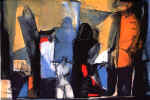BIOGRAPHY
född 1945 Utbildning Konstfack 1965-69 Separatutställningar , urval Galleri Holm Malmö -8 Galleri Eva Solvang Stockholm -7 Galleri Vättern Motala -7 Galleri Bergman Karlstad -6 Litografiskamuseet Tidaholm -5 Pelles Lusthus Nyköping -5 Galleri Eva Solvang Sthlm -02,03,05,10 Konsthallen Luleå -2 Galleri Astley Uttersberg -01,05 Olsson & Uddenberg Göteborg -01,09 Höganäs museum Höganäs 0 Konstnärshuset Sthlm -99 Galleri Linnè Uppsala -97,02,06,09 Galleri S Östersund -97,02,07 Galleri 33 Göteborg -95 Galleri Bergström Jönköping -95 Galleri Kopparmöllan Helsingborg -93,96 Galleri Axlund Sthlm -93,96 Camage Gallery Västerås -92 Galleri Aix Sthlm -90 Aguélimuseet Sala -89 Stockholm Art Fair Sthlm -89,91,98,04 Galleri Aveny Göteborg -85 Galleri Versalen Sundsvall -83,90 Galleri Heland Sthlm -82 Kiruna Stadshus Kiruna -81 Galleri Belle Västerås -73,75 Galleri Prisma Sthlm -71,74 Samlingsutställningar , urval Nordisk akvarell Sthlm,Aalborg,Köpenhamn Konsthallen Kristianstad Eksjö museum Eksjö Odense Danmark Konst på papper Sthlm Konstmuseet Västerås Nolhaga Slott Alingsås Stadshuset,självporträtt Kiruna Teckningstriennaler Landskrona Unga tecknare Sthlm Representerad Nationalmuseum Sthlm Norrköpings museum Norrköping Sundsvalls museum Sundsvall Eksjö museum Eksjö Sveriges Riksdag Sthlm Kiruna stadshus Kiruna Västerås museum Västerås Teckningsmuseet Laholm Statens konstråd Litografiska museet Tidaholm Stipendier Sthlm:s kulturstipendium -00 Skärgårdsstipendiet -90 Kirunastipendiet -80 Sthlm:s kulturstipendium -74 Litteratur Tänk på avståndet, W&P -07 Suveräna platser...,Carlssons -99 Flanörens öga, Carlssons -96 Teckningar -88 ______________________________________________________ Berndt Wennström: A painter with abstract vitality Berndt Wennström was born in Stockholm in 1945. He grew up in the western suburb of Bromma but has lived for many years in Söder - the southern part of the city and his favorite section - where he has a studio on ... Berndt received his training as a graphic designer at the Swedish School of Arts, Crafts and Design during the years from 1965 through 1969. When he graduated, he and two friends rented one of Staffan Hallström's two studios on Munkbrogatan in Stockholm's Old City. Berndt considers the years with Staffan Hallström as his true education, but he did not become a full-time painter until some years later. During the intervening years he supported himself as a designer in book publishing companies and advertising agencies. Berndt made his debut in 1971 with a one-man show at the Galleri Prisma in Stockholm. Birds were one of his early favorite subjects but after a while he discovered they were not as rewarding as humans as objects of abstraction. He now studies people diligently by going about the city on foot or bicycle, equipped with a sketchbook. What interests him primarily are crowds of people: in caf6s, at bus stops, in the underground, in parks and other public environments. This approach has yielded him a bulging library of drawings that he can consult when he is working on subjects for his paintings and drawings. Berndt is a skilled and rapid draftsman, in particular when depicting people in social situations: drinking, in conversation, waiting in line, and the like. As a painter he has to guard continuously against this skill to avoid ending up creating illustrations. The observations and notations in his sketchbook provide the foundation for his painting. He often begins by sketching in charcoal on the canvas, indicating crude lines. He avoids brushes because they tempt him to yield to details. '[instead he cuts out pieces of cardboard and uses them to stroke on the oil paint in powerful sweeps. This is one of the many ways in which he strengthens his concentration on the abstract. Another is to turn the half-finished painting upside down while he is working. Being an abstractionist can also mean turning reality upside down. A drawing of four giggling girls eating ice cream became, for example, a painfully threatening picture of a meeting of four dictatorial potentates. Berndt now and then sneaks an element of social satire into his paintings. On many occasions he has "borrowed" and transformed photographs from "Månadsjournalen", an elegant monthly journal. An executive sunk deep in a leather armchair, surrounded by small attributes of power, amuses him. So do an ambassador and his wife, posing rigidly in the home environment of an embassy residence filled with semiofficial status symbols. The painter9s empathy lies with ordinary men and women: old ladies feeding birds, or old men who sit and chat over a glass of beer in a pub. In his paintings, Berndt shifts between the figurative and the abstract. His starting point is nearly always representational but he can develop the same motif toward increasingly varied forms in different paintings. His human figures are always identifiable but depersonalized, while his depiction of space is often nonfigurative. With strong warm or cool colors, he creates an emotional environment for his figures. He not only creates tension between the figures and the abstract surroundings but also between abstract elements in his portrayal of space. One way in which he does this is by applying a stroke of black with calligraphic sharpness, suddenly charging the bright parts of the canvas. Berndt learned this irrational method of increasing the vitality of a painting from Wilem de Kooning, the American artist, who also uses photographs as models, generalizing them and introducing them as fragments in his color-charged abstract painting. In other respects, Berndt's Swedish teacher, Staffan Hallström, has meant a great deal to him in terms of his rich coloring and spontaneous attack on the canvas. Berndt, his wife, and their two children live in the southern section of Stockholm. He has retained his interest in flying objects, traveling to the island of Oland, or to Skåne, in the south of Sweden, to study bird life. But he does not presume to call himself an ornithologist. His interest is more esthetic. Berndt Wennström has had a large number of one-man shows since 1971 and he has also participated in collective exhibitions where he has displayed his drawings. He is represented in the Sundsvall and Västerås museums and in Kiruna's City Hall. The National Arts Council has acquired many of his works.

















